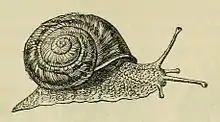Eremina desertorum
Eremina desertorum (formerly Helix desertorum) is a species of land snails in the genus Eremina.[1][2][3]
| Eremina desertorum | |
|---|---|
 | |
| The revived British Museum specimen (Woodcut, after a drawing by A. N. Waterhouse, from page 7 of the book 'A Manual of the Mollusca' (1851), by Samuel Pickworth Woodward. | |
| Scientific classification | |
| Kingdom: | Animalia |
| Phylum: | Mollusca |
| Class: | Gastropoda |
| Subclass: | Heterobranchia |
| Superorder: | Eupulmonata |
| Order: | Stylommatophora |
| Family: | Helicidae |
| Genus: | Eremina |
| Species: | E. desertorum |
| Binomial name | |
| Eremina desertorum (Forskål, 1775) | |
| Synonyms | |
| |
A specimen from Egypt, in the British Museum, and thought to be dead, was glued to an index card in March 1846. However, in March 1850, it was nevertheless found to be alive.[4] The Canadian writer Grant Allen observed:[5]
The Museum authorities accordingly ordered our friend a warm bath (who shall say hereafter that science is unfeeling!), upon which the grateful snail, waking up at the touch of the familiar moisture, put his head cautiously out of his shell, walked up to the top of the basin, and began to take a cursory survey of British institutions with his four eye-bearing tentacles. So strange a recovery from a long torpid condition, only equalled by that of the Seven Sleepers of Ephesus, deserved an exceptional amount of scientific recognition.
It is reported that the museum specimen was then transferred to a large glass jar where it lived for a further two years subsisting largely on cabbage leaves.[6] During this period it successfully re-entered and left torpor once more.[6]
References
- "Eremina desertorum". Encyclopedia of Life. Retrieved 17 July 2015.
- Fahmy, O. G. (June 1949). "Oogenesis in the desert snail Eremina desertorum with special reference to vitellogenesis". Q J Microsc Sci. 90 Pt. 2 (2): 159–81. PMID 18132293.
- Hassan, Kamaleldin M. (2015). "Stable isotopic signatures of the modern land snail Eremina desertorum from a low-latitude (hot) dry desert – A study from the Petrified Forest, New Cairo, Egypt". Chemie der Erde – Geochemistry. 75 (1): 65–72. doi:10.1016/j.chemer.2014.09.002. ISSN 0009-2819.
- "The desert snail at once awoke and found himself famous". MetaFilter. Retrieved 17 July 2015.
- Allen, Grant (1889). Falling in Love; With Other Essays on More Exact Branches of Science. London: Smith, Elder & Co.
- Hamilton, James (1854). Excelsior: Helps to Progress in Religion, Science, and Literature. 1. James Nisbet and Co. pp. 344–45.
